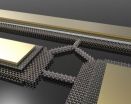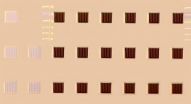(Press-News.org) The Neurogrid circuit board can simulate orders of magnitude more neurons and synapses than other brain mimics on the power it takes to run a tablet computer.
Stanford scientists have developed a new circuit board modeled on the human brain, possibly opening up new frontiers in robotics and computing.
For all their sophistication, computers pale in comparison to the brain. The modest cortex of the mouse, for instance, operates 9,000 times faster than a personal computer simulation of its functions.
Not only is the PC slower, it takes 40,000 times more power to run, writes Kwabena Boahen, associate professor of bioengineering at Stanford, in an article for the Proceedings of the IEEE.
"From a pure energy perspective, the brain is hard to match," says Boahen, whose article surveys how "neuromorphic" researchers in the United States and Europe are using silicon and software to build electronic systems that mimic neurons and synapses.
Boahen and his team have developed Neurogrid, a circuit board consisting of 16 custom-designed "Neurocore" chips. Together these 16 chips can simulate 1 million neurons and billions of synaptic connections. The team designed these chips with power efficiency in mind. Their strategy was to enable certain synapses to share hardware circuits. The result was Neurogrid – a device about the size of an iPad that can simulate orders of magnitude more neurons and synapses than other brain mimics on the power it takes to run a tablet computer.
The National Institutes of Health funded development of this million-neuron prototype with a five-year Pioneer Award. Now Boahen stands ready for the next steps – lowering costs and creating compiler software that would enable engineers and computer scientists with no knowledge of neuroscience to solve problems – such as controlling a humanoid robot – using Neurogrid.
Its speed and low power characteristics make Neurogrid ideal for more than just modeling the human brain. Boahen is working with other Stanford scientists to develop prosthetic limbs for paralyzed people that would be controlled by a Neurocore-like chip.
"Right now, you have to know how the brain works to program one of these," said Boahen, gesturing at the $40,000 prototype board on the desk of his Stanford office. "We want to create a neurocompiler so that you would not need to know anything about synapses and neurons to able to use one of these."
Brain ferment
In his article, Boahen notes the larger context of neuromorphic research, including the European Union's Human Brain Project, which aims to simulate a human brain on a supercomputer. By contrast, the U.S. BRAIN Project – short for Brain Research through Advancing Innovative Neurotechnologies – has taken a tool-building approach by challenging scientists, including many at Stanford, to develop new kinds of tools that can read out the activity of thousands or even millions of neurons in the brain as well as write in complex patterns of activity.
Zooming from the big picture, Boahen's article focuses on two projects comparable to Neurogrid that attempt to model brain functions in silicon and/or software.
One of these efforts is IBM's SyNAPSE Project – short for Systems of Neuromorphic Adaptive Plastic Scalable Electronics. As the name implies, SyNAPSE involves a bid to redesign chips, code-named Golden Gate, to emulate the ability of neurons to make a great many synaptic connections – a feature that helps the brain solve problems on the fly. At present a Golden Gate chip consists of 256 digital neurons each equipped with 1,024 digital synaptic circuits, with IBM on track to greatly increase the numbers of neurons in the system.
Heidelberg University's BrainScales project has the ambitious goal of developing analog chips to mimic the behaviors of neurons and synapses. Their HICANN chip – short for High Input Count Analog Neural Network – would be the core of a system designed to accelerate brain simulations, to enable researchers to model drug interactions that might take months to play out in a compressed time frame. At present, the HICANN system can emulate 512 neurons each equipped with 224 synaptic circuits, with a roadmap to greatly expand that hardware base.
Each of these research teams has made different technical choices, such as whether to dedicate each hardware circuit to modeling a single neural element (e.g., a single synapse) or several (e.g., by activating the hardware circuit twice to model the effect of two active synapses). These choices have resulted in different trade-offs in terms of capability and performance.
In his analysis, Boahen creates a single metric to account for total system cost – including the size of the chip, how many neurons it simulates and the power it consumes.
Neurogrid was by far the most cost-effective way to simulate neurons, in keeping with Boahen's goal of creating a system affordable enough to be widely used in research.
Speed and efficiency
But much work lies ahead. Each of the current million-neuron Neurogrid circuit boards cost about $40,000. Boahen believes dramatic cost reductions are possible. Neurogrid is based on 16 Neurocores, each of which supports 65,536 neurons. Those chips were made using 15-year-old fabrication technologies.
By switching to modern manufacturing processes and fabricating the chips in large volumes, he could cut a Neurocore's cost 100-fold – suggesting a million-neuron board for $400 a copy. With that cheaper hardware and compiler software to make it easy to configure, these neuromorphic systems could find numerous applications.
For instance, a chip as fast and efficient as the human brain could drive prosthetic limbs with the speed and complexity of our own actions – but without being tethered to a power source. Krishna Shenoy, an electrical engineering professor at Stanford and Boahen's neighbor at the interdisciplinary Bio-X center, is developing ways of reading brain signals to understand movement. Boahen envisions a Neurocore-like chip that could be implanted in a paralyzed person's brain, interpreting those intended movements and translating them to commands for prosthetic limbs without overheating the brain.
A small prosthetic arm in Boahen's lab is currently controlled by Neurogrid to execute movement commands in real time. For now it doesn't look like much, but its simple levers and joints hold hope for robotic limbs of the future.
Of course, all of these neuromorphic efforts are beggared by the complexity and efficiency of the human brain.
In his article, Boahen notes that Neurogrid is about 100,000 times more energy efficient than a personal computer simulation of 1 million neurons. Yet it is an energy hog compared to our biological CPU.
"The human brain, with 80,000 times more neurons than Neurogrid, consumes only three times as much power," Boahen writes. "Achieving this level of energy efficiency while offering greater configurability and scale is the ultimate challenge neuromorphic engineers face."
INFORMATION:
Tom Abate writes about the students, faculty and research of the School of Engineering. Amy Adams of Stanford University Communications contributed to this report.
For more Stanford experts in bioengineering and other topics, visit Stanford Experts.
Stanford scientists create circuit board modeled on the human brain
2014-04-28
ELSE PRESS RELEASES FROM THIS DATE:
Using a foreign language changes moral decisions
2014-04-28
Would you sacrifice one person to save five? Such moral choices could depend on whether you are using a foreign language or your native tongue.
A new study from psychologists at the University of Chicago and Pompeu Fabra University in Barcelona finds that people using a foreign language take a relatively utilitarian approach to moral dilemmas, making decisions based on assessments of what's best for the common good. That pattern holds even when the utilitarian choice would produce an emotionally difficult outcome, such as sacrificing one life so others could live.
"This ...
UEA research shows bacteria combat dangerous gas leaks
2014-04-28
Bacteria could mop up naturally-occurring and man-made leaks of natural gases before they are released into the atmosphere and cause global warming - according to new research from the University of East Anglia.
Findings published today in the journal Nature shows how a single bacterial strain (Methylocella silvestris) found in soil and other environments around the world can grow on both the methane and propane found in natural gas.
It was originally thought that the ability to metabolize methane and other gaseous alkanes such as propane was carried out by different ...
How to create nanowires only 3 atoms wide with an electron beam
2014-04-28
Junhao Lin, a Vanderbilt University Ph.D. student and visiting scientist at Oak Ridge National Laboratory (ORNL), has found a way to use a finely focused beam of electrons to create some of the smallest wires ever made. The flexible metallic wires are only three atoms wide: One thousandth the width of the microscopic wires used to connect the transistors in today's integrated circuits.
Lin's achievement is described in an article published online on April 28 by the journal Nature Nanotechnology. According to his advisor Sokrates Pantelides, University Distinguished Professor ...
First disease-specific human embryonic stem cell line by nuclear transfer
2014-04-28
NEW YORK, NY (April 28, 2014) – Using somatic cell nuclear transfer, a team of scientists led by Dr. Dieter Egli at the New York Stem Cell Foundation (NYSCF) Research Institute and Dr. Mark Sauer at Columbia University Medical Center has created the first disease-specific embryonic stem cell line with two sets of chromosomes.
As reported today in Nature, the scientists derived embryonic stem cells by adding the nuclei of adult skin cells to unfertilized donor oocytes using a process called somatic cell nuclear transfer (SCNT). Embryonic stem cells were created from one ...
UCLA scientists hunt down origin of Huntington's disease in the brain
2014-04-28
The gene mutation that causes Huntington's disease appears in every cell in the body, yet kills only two types of brain cells. Why? UCLA scientists used a unique approach to switch the gene off in individual brain regions and zero in on those that play a role in causing the disease in mice.
Published in the April 28 online edition of Nature Medicine, the research sheds light on where Huntington's starts in the brain. It also suggests new targets and routes for therapeutic drugs to slow the devastating disease, which strikes an estimated 35,000 Americans.
"From ...
The scent of a man
2014-04-28
Scientists' inability to replicate research findings using mice and rats has contributed to mounting concern over the reliability of such studies.
Now, an international team of pain researchers led by scientists at McGill University in Montreal may have uncovered one important factor behind this vexing problem: the gender of the experimenters has a big impact on the stress levels of rodents, which are widely used in preclinical studies.
In research published online April 28 in Nature Methods, the scientists report that the presence of male experimenters produced a ...
Mount Sinai scientists identify first gene linked to heart muscle disease in children
2014-04-28
Scientists at Icahn School of Medicine at Mount Sinai, along with collaborators at institutions in India, Italy, and Japan, have identified the first gene linked to childhood-onset familial dilated cardiomyopathy (DCM), one of the most common heart muscle diseases in children. It is a progressive and potentially fatal heart condition resulting from an enlarged and weakened heart muscle.
The study, published in Nature Genetics, also revealed a link between DCM and excessive activation of the protein, mTOR. Currently, there are several existing FDA-approved blocking ...
Viral 'parasites' may play a key role in the maintenance of cell pluripotency
2014-04-28
In a study published in Nature Genetics, scientists from the RIKEN Center for Life Science Technologies in Japan, in collaboration with the RIKEN Center for Integrative Medical Sciences, the University of Copenhagen and the Joint Genome Institute (Walnut Creek, California) have discovered that "jumping DNA" known as retrotransposons—viral elements incorporated into the human genome—may play a key role in the maintenance of pluripotency, the ability of stem cells to differentiate into many different types of body cells.
This story is part of a fundamental rethinking taking ...
Researchers identify mechanism of cancer caused by loss of BRCA1 and BRCA2 gene function
2014-04-28
BOSTON – Inherited mutations in the BRCA1 or BRCA2 tumor suppressor genes are by far the most frequent contributors to hereditary cancer risk in the human population, often causing breast or ovarian cancer in young women of child-bearing age. Attempts to test the role that the BRCA genes play in regulating a repair process associated with genome duplication have proven frustratingly difficult in living mammalian cells.
Now investigators at Beth Israel Deaconess Medical Center (BIDMC) report a new mechanism by which BRCA gene loss may accelerate cancer-promoting chromosome ...
Multilayer, microscale solar cells enable ultrahigh efficiency power generation
2014-04-28
Researchers at the University of Illinois at Urbana-Champaign use a printing process to assemble tiny cells into multilayer stacks for extraordinary levels of photovoltaic conversion efficiency.
As an energy source, the Sun has always been a dependable provider. Although it freely shines on everyone, the ability to capture and convert the Sun's abundant energy is anything but free. However, new technologies aimed at achieving "full spectrum" operation in utility-scale photovoltaics may soon make solar energy a viable option.
"A few simple ideas in materials science ...



